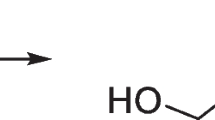Abstract
A self-extinguishing epoxy molding compound that does not have any flame-retarding additives, such as halogen compounds, has been developed for electronic components. This compound enables the overcoming of environmental issues posed by these flame-retarding additives when compounds containing such additives are burned and disposed of. The molding compound contains phenol aralkyl-type epoxy resin and hardener, both of which include a specific multi-aromatic moiety (biphenylene) in novolac resin structure. The compound extinguished itself after ignition because it formed a stable foam layer on the resin surface during the ignition due to the low elasticity at high temperatures and high pyrolysis resistance of the compound after curing. The foam layer effectively retarded the transfer of heat to the inside during the ignition. Adding silica filler to the molding compound resulted in the synergistic effectiveness of the compound for flame resistance because it increased the foam-layer stability during burning. The molding compound showed other excellent characteristics, including moldability, water resistance, and package reliability. In fact, its resistance to soldering heat, humidity, and high-temperature storage was much better than that of current high-quality epoxy molding compounds containing halogen-type flame-retarding additives.
Similar content being viewed by others
References
M. G. Pecht, L. T. Nguyen and E. B. Hakim, in “Plastic-Encapsulated Microelectronics” (Wiley, New York, 1995).
K. Dusek, in “Advanced in Polymer Science 88” (Heidelberg, Springer-Verlag, Berlin, 1989) pp. 1-48.
G. Camino and L. Costa, Poly. Degrad. Stability 20 (1998) 271-294.
R. Dumler, H. Thoma and O. Hutzinger, Chemosphere 19(1–6) (1989) 305-308.
R. Luijk, H. A. J. Govers, G. B. Eijkel and J. Boon, J. Anal. Appl. Pyrol. 20 (1991) 303-319.
A. D. La Rosa, S. Filla, P. Finocchiaro, A. Recca and V. Siracusa, J. Polym. Eng. 19(3) (1999) 151-160.
H. Carlsson, U. Nilsson, and C. Ostman, Environ. Sci. Technol. 34 (2000) 3885-3889.
K. Hasegawa, A. Fukuda and S. Tonogi, J. Appl. Polym. Sci. 37 (1989) 3423-3435.
M. Cizmecioglu, A. Gupta and R. F. Fedors, ibid. 32 (1986) 6177-6190.
C. S. Chen, B. J. Bulkin and E. M. Pearce ibid. 27 (1982) 3289-3312.
M. Iji and Y. Kiuchi, Polymers for Advanced Technologies 12 (2001) 393-406.
M. Iji and Y. Kiuchi, in Proceedings of the 3rd 1999 IEMT/IMC Symp. (1999) pp. 238-241.
D. W. Van Krevelen, Polymer, 16, August (1975) 615-620.
P. Y. Liu and W. H. Bassett, in Proceedings of Int. Symp. Flame Retard. (1989) 500-505.
I. Fukuzawa, S. Ishiguro and S. Nambu, in Proceedings of Int. Reli. Phys. Symp. (1985) 192-197.
T. O. Steiner and D. Suhl, IEEE Trans. Components, Hybrids, Manufact. Technol. CHMT-10, 2 (1987) 209-216.
S. Asai, U. Saruta and M. Tobita, J. Appl. Polym. Sci. 51 (1994) 1945-1958.
Author information
Authors and Affiliations
Rights and permissions
About this article
Cite this article
Iji, M., Kiuchi, Y. Self-extinguishing epoxy molding compound with no flame-retarding additives for electronic components. Journal of Materials Science: Materials in Electronics 12, 715–723 (2001). https://doi.org/10.1023/A:1012940826406
Issue Date:
DOI: https://doi.org/10.1023/A:1012940826406




